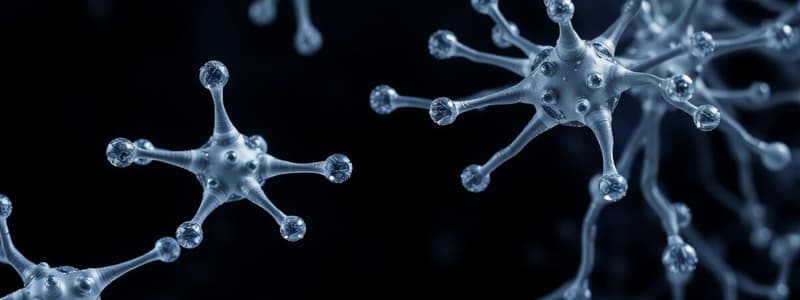Podcast
Questions and Answers
Which of the following effects does cocaethylene have compared to cocaine?
Which of the following effects does cocaethylene have compared to cocaine?
- Increased euphoric effect (correct)
- Shorter half-life
- Less toxic
- Weaker vasoconstrictor
Cocaethylene acts as a strong depressant of the nervous system.
Cocaethylene acts as a strong depressant of the nervous system.
False (B)
What is the primary neurotransmitter whose reuptake cocaine blocks?
What is the primary neurotransmitter whose reuptake cocaine blocks?
Dopamine
Cocaethylene has a half-life of approximately _____ minutes in the body.
Cocaethylene has a half-life of approximately _____ minutes in the body.
Match the following effects with their corresponding categories related to cocaine and cocaethylene:
Match the following effects with their corresponding categories related to cocaine and cocaethylene:
What is a common effect of high doses of cocaine?
What is a common effect of high doses of cocaine?
Cocaine use can lead to persistent euphoria and increased judgment.
Cocaine use can lead to persistent euphoria and increased judgment.
What physiological impact can cocaine have on newborns if the mother uses it during pregnancy?
What physiological impact can cocaine have on newborns if the mother uses it during pregnancy?
The acute toxic dose of cocaine is approximately _____ mg/kg.
The acute toxic dose of cocaine is approximately _____ mg/kg.
Match the following effects with the respective substance:
Match the following effects with the respective substance:
What is the primary neurotransmitter that psychostimulants augment?
What is the primary neurotransmitter that psychostimulants augment?
Cocaine is synthesized from the leaves of the coca plant.
Cocaine is synthesized from the leaves of the coca plant.
What is the half-life of cocaine in plasma?
What is the half-life of cocaine in plasma?
Cocaine that is soluble in alcohol, acetone, or ether is known as __________.
Cocaine that is soluble in alcohol, acetone, or ether is known as __________.
Match the following forms of cocaine with their characteristics:
Match the following forms of cocaine with their characteristics:
What percentage of a snorted dose of cocaine is absorbed through the nasal mucosa?
What percentage of a snorted dose of cocaine is absorbed through the nasal mucosa?
Cocaine is slowly removed from the brain, taking 8 or more hours after initial use.
Cocaine is slowly removed from the brain, taking 8 or more hours after initial use.
What is the major metabolite of cocaine detected in urine?
What is the major metabolite of cocaine detected in urine?
What is the half-life of cocaine?
What is the half-life of cocaine?
Amphetamines act as local anesthetics.
Amphetamines act as local anesthetics.
What neurotransmitters does amphetamine primarily affect?
What neurotransmitters does amphetamine primarily affect?
At high doses, amphetamine can prevent dopamine degradation by binding to _____ .
At high doses, amphetamine can prevent dopamine degradation by binding to _____ .
Match the pharmacological effects of low to moderate doses of amphetamine with their descriptions:
Match the pharmacological effects of low to moderate doses of amphetamine with their descriptions:
Which of the following is a characteristic of high-dose amphetamine use?
Which of the following is a characteristic of high-dose amphetamine use?
Amphetamine metabolites can be detected in urine for up to 72 hours after consumption.
Amphetamine metabolites can be detected in urine for up to 72 hours after consumption.
What potential impact does amphetamine use have during athletic competitions?
What potential impact does amphetamine use have during athletic competitions?
What is a notable challenge in identifying the effects of drug use during pregnancy?
What is a notable challenge in identifying the effects of drug use during pregnancy?
Withdrawal syndrome from opioids is usually more dramatic than from other substances.
Withdrawal syndrome from opioids is usually more dramatic than from other substances.
At what age do children display higher scores for anxiety, depression, and aggression due to exposure to drugs in pregnancy?
At what age do children display higher scores for anxiety, depression, and aggression due to exposure to drugs in pregnancy?
Symptoms of withdrawal can include increased appetite, weight gain, and a need for increased _____ .
Symptoms of withdrawal can include increased appetite, weight gain, and a need for increased _____ .
Match the symptoms with their corresponding effects associated with opioid withdrawal:
Match the symptoms with their corresponding effects associated with opioid withdrawal:
What is the primary route of administration for the crystalline form of methamphetamine known as 'ice'?
What is the primary route of administration for the crystalline form of methamphetamine known as 'ice'?
Methamphetamine has a relatively short half-life of about 3 hours.
Methamphetamine has a relatively short half-life of about 3 hours.
What are two health risks associated with high doses of methamphetamine?
What are two health risks associated with high doses of methamphetamine?
The metabolic process of methamphetamine results in about _____ percent being metabolized in the liver.
The metabolic process of methamphetamine results in about _____ percent being metabolized in the liver.
Match the following potential effects of methamphetamine use with their descriptions:
Match the following potential effects of methamphetamine use with their descriptions:
Flashcards
Psychostimulants
Psychostimulants
Drugs that increase brain activity by boosting neurotransmitters like dopamine. They also mimic the "fight or flight" response of the sympathetic nervous system.
Cocaine's origin
Cocaine's origin
Cocaine is extracted from the leaves of the coca plant.
Cocaine's medical use
Cocaine's medical use
Cocaine is used as a local anesthetic during surgeries.
Crack Cocaine
Crack Cocaine
Signup and view all the flashcards
Cocaine Absorption Sites
Cocaine Absorption Sites
Signup and view all the flashcards
Cocaine in the Brain
Cocaine in the Brain
Signup and view all the flashcards
Cocaine Elimination
Cocaine Elimination
Signup and view all the flashcards
Cocaine Detection
Cocaine Detection
Signup and view all the flashcards
Cocaethylene
Cocaethylene
Signup and view all the flashcards
How does cocaethylene affect dopamine?
How does cocaethylene affect dopamine?
Signup and view all the flashcards
What are the main effects of cocaethylene?
What are the main effects of cocaethylene?
Signup and view all the flashcards
Cocaethylene's Toxicity
Cocaethylene's Toxicity
Signup and view all the flashcards
Half-life of Cocaethylene
Half-life of Cocaethylene
Signup and view all the flashcards
Cocaine's initial effect
Cocaine's initial effect
Signup and view all the flashcards
Cocaine's rapid tolerance
Cocaine's rapid tolerance
Signup and view all the flashcards
Higher cocaine doses
Higher cocaine doses
Signup and view all the flashcards
Amphetamine impact on brain
Amphetamine impact on brain
Signup and view all the flashcards
Adderall's components
Adderall's components
Signup and view all the flashcards
d-Amphetamine's Abuse
d-Amphetamine's Abuse
Signup and view all the flashcards
Amphetamine vs. Cocaine: Duration
Amphetamine vs. Cocaine: Duration
Signup and view all the flashcards
Cocaine's Half-Life
Cocaine's Half-Life
Signup and view all the flashcards
Amphetamine's Mechanism of Action
Amphetamine's Mechanism of Action
Signup and view all the flashcards
Amphetamine's Effects on Dopamine
Amphetamine's Effects on Dopamine
Signup and view all the flashcards
Amphetamine's Effects at Low Doses
Amphetamine's Effects at Low Doses
Signup and view all the flashcards
Amphetamine's Effects at High Doses
Amphetamine's Effects at High Doses
Signup and view all the flashcards
Amphetamine's Performance Enhancement
Amphetamine's Performance Enhancement
Signup and view all the flashcards
Pregnancy and Meds: Clear Pattern?
Pregnancy and Meds: Clear Pattern?
Signup and view all the flashcards
Early Childhood Impact
Early Childhood Impact
Signup and view all the flashcards
Withdrawal Symptoms
Withdrawal Symptoms
Signup and view all the flashcards
Tolerance and Drug Abuse
Tolerance and Drug Abuse
Signup and view all the flashcards
Managing Withdrawal
Managing Withdrawal
Signup and view all the flashcards
Methamphetamine's Mechanism
Methamphetamine's Mechanism
Signup and view all the flashcards
Methamphetamine's 'Ice' Form
Methamphetamine's 'Ice' Form
Signup and view all the flashcards
Methamphetamine's Half-Life
Methamphetamine's Half-Life
Signup and view all the flashcards
Methamphetamine Neurotoxicity
Methamphetamine Neurotoxicity
Signup and view all the flashcards
Methamphetamine's Effects on High Doses
Methamphetamine's Effects on High Doses
Signup and view all the flashcards




